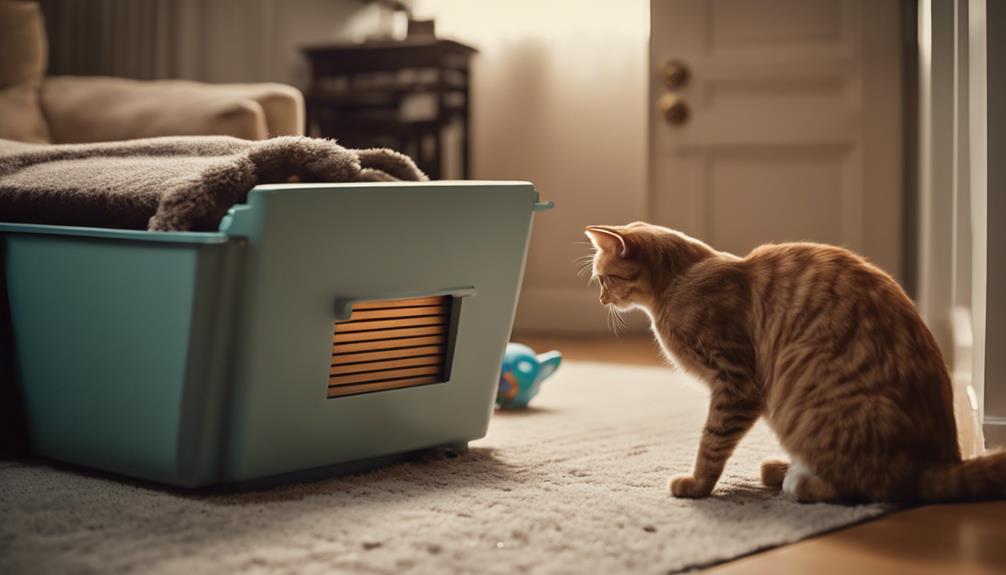When it comes to introducing a new litter box to your cat, it's important to approach the transition with care and patience. Making simple adjustments and following a few key tips can help ease the process for your feline friend. From the placement of the litter box to the type of litter you use, each step plays a crucial role in ensuring a smooth transition. By implementing these strategies, you can set the stage for a successful change that benefits both you and your cat in the long run.
Place Litter Box in Ideal Location
When introducing a new litter box, it's crucial to place it in the ideal location to ensure your cat's comfort and ease of transition. Cats are creatures of habit and prefer a calm, private spot for their litter box. This familiar setting helps them adjust to the change more smoothly.
Selecting a quiet location for the new litter box is essential as it encourages regular use without hesitation. Cats appreciate consistency, so placing the new box in a similar location to the previous one can reduce stress during the transition period. By minimizing changes in the box's location, you're creating a comfortable environment for your feline friend to do their business without any fuss.
Choose Preferred Litter Type
To ensure your cat's comfort and encourage regular use of the litter box, opt for a fine-grained litter that offers a soft texture preferred by most felines. When choosing the right type of litter for your cat, consider the following tips:
- Stick to Fine-Grained Litters: Cats generally prefer fine-grained litters as they're softer on their paws.
- Avoid Pellet-Type Litters: Pellet-type litters or those made from citrus peels may not be favored by cats.
- Consistency is Key: Stick to one type and brand of litter that your cat already prefers to avoid confusion during the transition.
- Skip Scented Litters: Scented or deodorant litters with strong odors can deter cats from using the box.
- Try Baking Soda: Consider using a thin layer of baking soda in the litter box to help absorb odors without putting off your cat.
Keep Litter Box Clean and Fresh
To maintain your cat's litter box cleanliness and freshness, it's important to clean it daily and change the litter regularly. Cats are particular about their litter box habits, so introducing a new one requires keeping it clean and comfortable. Clean the litter box daily to remove any waste and maintain a fresh environment for your cat. Changing the litter regularly, based on the type of litter and the number of cats using the box, is essential to prevent odor buildup and ensure your cat's comfort.
When cleaning the litter box, avoid using strong-smelling chemicals that may repel your cat. Instead, opt for soap and water to wash the box consistently. A clean litter box not only helps with odor control but also contributes to your cat's hygiene and well-being. By establishing a routine of daily cleaning and regular litter changes, new cat owners can create a welcoming and hygienic environment for their feline friends.
Ensure Easy Access for Your Cat
Place the litter box in a location that's convenient and private for your cat's comfort. When introducing a new cat litter box, ensuring easy access is crucial for your feline friends to feel comfortable and at ease while conducting their business. Here are some tips to help you achieve this:
- Avoid Loud Areas: Keep the litter box away from noisy appliances to prevent stress.
- Ensure Reachability: Make sure the litter box is easily accessible to prevent any issues.
- Choose a Private Spot: Consider using a closet or bathroom for the litter box, providing privacy.
- Add Comfort: Place a small rug under the litter box for a comfortable scratching surface.
- Consider Accessibility: Think about the type of box that's easiest for your cat to enter and exit.
Be Patient During the Transition
During the transition to a new litter box, patience and understanding of your cat's behavior are essential. Cats are creatures of habit, particularly when it comes to their litter box. Introducing a new box may require time for your cat to adjust to the change. Rushing the process can lead to stress and your cat avoiding the new litter box.
It's a good idea to encourage your cat to start using the new box gradually. Positive reinforcement, such as treats or praise, can help your cat feel more comfortable with the transition. Remember, cats are clean animals and prefer their litter box to be kept clean.
Be patient if your cat has accidents during the adjustment period. Avoid punishing them as it can create a negative association with the new box. With time and patience, your cat will likely adapt to using the new litter box successfully.
Frequently Asked Questions
How Do I Attract My Cat to My New Litter Box?
To attract your cat to the new litter box, place toys or treats nearby, reward them with treats for using it, mix a bit of used litter for a comforting scent, keep the cover off initially, and be patient.
Will a Cat Recognize a New Litter Box?
Yes, your cat will likely recognize a new litter box based on scents, location, and visuals. Familiarizing it with the old box's scents and placing it in the same spot can aid recognition. Patience and positive reinforcement help with acceptance.
How Do You Introduce a Second Litter Box to a Cat?
When introducing a second litter box to your cat, place it near the original one, keep it clean and filled with familiar litter, use treats to reinforce positive behavior, and observe your cat's comfort level for adjustments.
How Long Does It Take for Cats to Use a New Litter Box?
It varies for each cat when adjusting to a new litter box. Some cats adapt quickly, while others may take a few weeks. Observing their behavior and providing positive reinforcement can help speed up the process.






